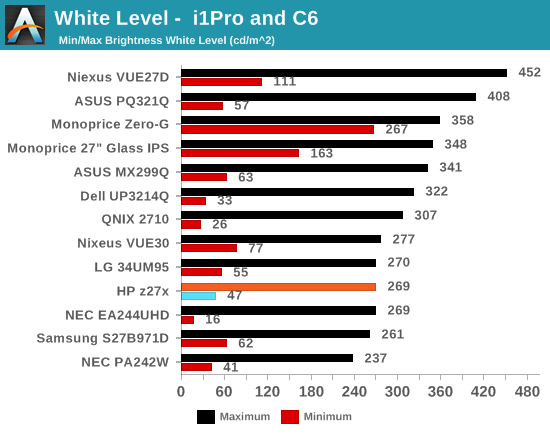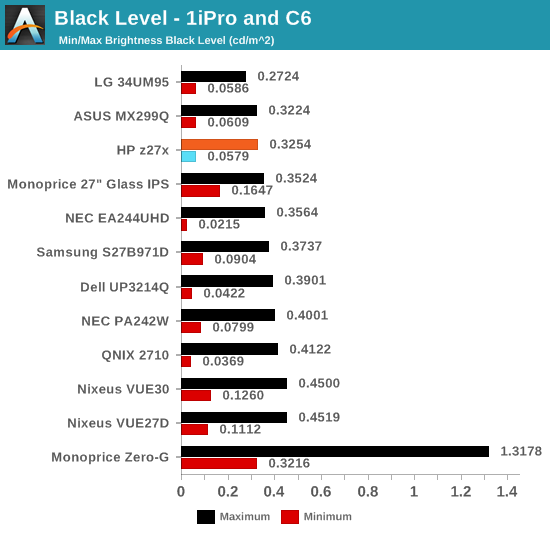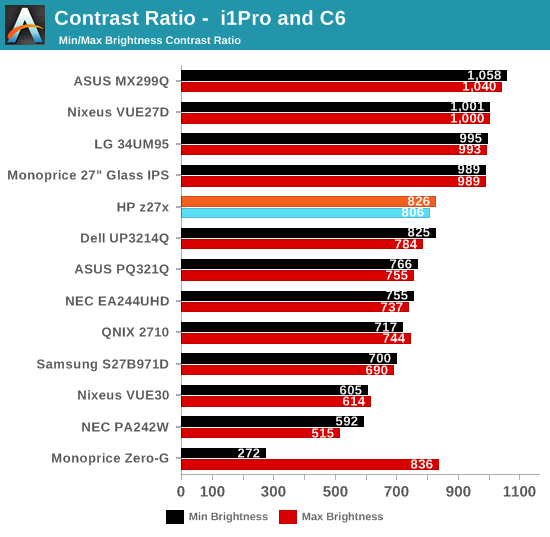HP z27x Review
by Chris Heinonen on December 2, 2014 4:00 PM ESTWith the backlight set to maximum, you only get 269 cd/m2 of brightness from the HP z27x. Many displays can go much brighter, but the z27x is meant to be used in more of a professional, production environment. Bright overhead lighting or direct sunlight are not going to be as much of a problem here, so you don’t need 350-400 cd/m2 to try to overcome those issues. It won’t work as well for such environments but you shouldn’t be using a $1,500 monitor in those situations either. At minimum brightness we get 47 cd/m2 of brightness. This is low enough for any real world use without going down to the unusable levels that some displays do.

Black levels are consistent with other professional level IPS panels. They are not as dark as an IPS panel can be, as the recent Retina iMac would demonstrate, but other performance aspects are more important than absolute black. The z27x would be improved by a better black level, but most of its target users should be fine with what it achieves.

The resulting contrast ratios here are around 815:1, or average for an IPS panel. There is no backlight control or anything else to enhance these beyond what they are. Under 1,000:1 is beginning to be not so great for an IPS panel, though almost all professional panels from NEC or others also fall into this range. It might seem strange that a professional display would value black levels less than a consumer one, but having an even gamma curve with visible shadow details is more important and contrast ratio can be sacrificed to achieve that,

The HP z27x data so far goes along with what I expect from a professional level display. Consumers that plan to watch movies and play games on their display might be happier with a display with improved contrast ratios. Professionals after different performance measures should be happy with the z27x numbers.










47 Comments
View All Comments
SanX - Sunday, December 7, 2014 - link
The author has done absolutely right things. HP indeed does not care even to cherrypick. HPs and Dells became more and more a rebranders of Chinese goods. And actually it is not the China the final reason in bad quality control of everything but WE THE BRAINDEAD PEOPLE and of course our croocky american sales/middlemen who exploit this vulnerability of average technically illiterate Joe and are just interested to drop more larger margin shiny crap on the heads of dumb public, on our heads.DanNeely - Tuesday, December 2, 2014 - link
It might've been the 1st time it crossed your desk; but NEC's offered in monitor calibration since (at least) the the Multysync 3090 (released around 2008). I'm not sure how it compares with HP's offering; but they've got something called NaViSet to allow centralized admin of display settings. Lastly, IIRC their internal calibration does have some ability to adjust for uneven backlighting (presumably at the cost of some overall contrast).http://www.necdisplay.com/support-and-services/nav...
cheinonen - Wednesday, December 3, 2014 - link
I've used and reviewed the NEC PA series, and while they offer an internal LUT with calibration options, it has to be done through the SpectraView II software. The HP allows you to do it entirely inside the display without a PC at all, making it easier to do a large number of them. The NEC PA series also lacks the Ethernet control. The uniformity on the NECs is top notch.baii9 - Tuesday, December 2, 2014 - link
Wide gamut -> GB-r LED -> uniformity issue, why am I not surprised.Here is when good warranty kick in, panel lottery.
Doomtomb - Tuesday, December 2, 2014 - link
This monitor came out in 2014? This looks like something that would've come out in 2009. The bezel is huge. The body is thick. The resolution is nothing special. I don't care if it has features, and the color gamut. Seriously, this is the mind of the average consumer.D. Lister - Tuesday, December 2, 2014 - link
This product isn't targeted at the average consumer.DanNeely - Wednesday, December 3, 2014 - link
Although one of the reasons why pro-grade monitors tend to be significantly thicker than consumer ones is to put an array of evenly spaced backlights behind the panel instead of just a few on one or more edges using mirrors to bounce it around; because the former results in more even illumination.Something that clearly didn't happen with this monitor; and since AT has proven willing to hold reviews if they see unexpectedly bad results and the vendor says "looks like something broke, let us send you a replacement to test" or "we didn't test that case and need to write a new firmware to fix the problem" I can only assume that HP considers the level of backlight variation Chris saw in this model acceptable.
kyuu - Thursday, December 4, 2014 - link
Based on Chris's own statement in these comments, your assumption would be wrong. It seems that Chris didn't inform HP or offer them the chance to send a replacement in order to avoid the appearance of receiving a "cherry picked" sample.... Seems kinda silly to me. Unless Chris purchased the review unit himself, HP already had the chance to submit a cherry picked sample. Giving them the chance to fix what may very well be damage incurred during shipping does not somehow break reviewer ethics.
baii9 - Wednesday, December 3, 2014 - link
average consumer don't drop 1.4k on a 27" monitor.jann5s - Wednesday, December 3, 2014 - link
The ASUS MX229Q is using more power at minimum then at maximum, I guess there is a booboo in the database (LCD Power Draw figure)